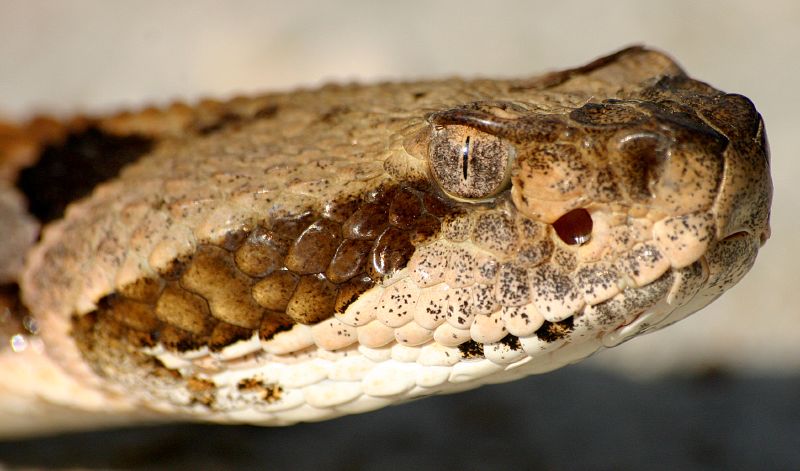Photo shows a Timber Rattlesnake.
CULLMAN – As the summer comes into full-swing and everyone spends more of their days outdoors, the potential for encounters with snakes grows.
North Alabama Private Lands Technical Assistance Biologist and Herpetologist Matt Brock knows how to help avoid dangerous meetings with the serpents roaming the Tennessee Valley.
“Always wear protective gear while working or recreating outside,” he said. “Leather boots that extend past the ankle are good, as well as thick leather gloves while working in gardens, flower beds, etcetera. Do not place hands and feet where you cannot see. Use a flashlight if walking or hiking after sunset. Most importantly, do not try to handle a venomous snake. Most snake bite victims are attempting to catch or kill a snake when bitten.”
According to Brock, North Alabama is home to six venomous species of snakes: Timber Rattlesnakes, Eastern Diamondback Rattlesnakes, Pigmy Rattlesnakes, Copperheads, Cottonmouths and Coral Snakes.
“The most dangerous snakes in North Alabama are going to be the Timber Rattlesnake and the Pigmy Rattlesnake,” Brock said. “Their bite is generally more severe than that of the Copperhead and Cottonmouth.”
Brock urges all to own a field-guide, which will help anyone identify the 45+ species of snakes that call North Alabama home, including the six venomous ones.
“If one can learn to ID those six, anything else they encounter will be harmless. In most of North Alabama, Eastern Diamondbacks and Coral Snakes will not be encountered,” he said.
Brock says not to count on a rattlesnake’s rattles to give them away, as they can be broken. Instead, one can identify any pit viper by the elliptical pupils and very “blocky” triangular shaped heads that are much larger than the neck.
“Some venomous snakes will flatten their heads to appear more dangerous when encountered, so observing the head is not always an accurate identifier,” he said. “In the case of the very rarely seen Coral Snake, the colors red and yellow will be touching, whereas in the case of the harmless Scarlet Snake and Red Milk Snake, the colors red and black will touch.”
Brock says it does not take much practice or time to be able to identify and differentiate between the venomous and non-venomous snakes in our area.
The easiest and most effective thing one can do to avoid snakes around the home and yard, according to Brock, is to keep a maintained yard and prevent large areas of debris or brush, as snakes hunt rats and mice those areas.
If one sees a snake on a hike or out walking, he says the best solution is to walk away from the snake. But, if one is bitten, he or she must calmly get a phone and contact the medical facility that he or she plans on going to.
“If a positive ID was made on the kind of snake, tell them the species of snake it was, that way they have time to prepare for your arrival. Most medical facilities rarely treat snake bites, if ever, because of the rarity of them,” Brock said. “Have someone else drive the victim to the hospital if possible. Do not elevate the extremity or limb that was bitten. It is best to stay calm and not increase the heart rate, as this can speed up the movement of venom throughout the body.”
However, Brock says, most snake bites are not fatal, even though they can be very painful.
“Most people make a full recovery, with very few long-term complications,” he said.
Lastly, according to Brock, moth balls and snake deterrents are ineffective. Removing places snakes can hide and hunt prey is much more effective.
For more information on venomous snakes in North Alabama, visit the Alabama Department of Conservation & Natural Resources online at http://outdooralabama.com/venomous-snakes.

























